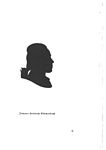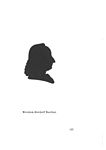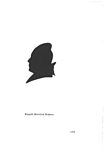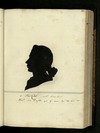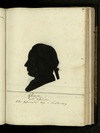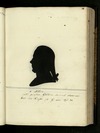Schubert silhouettes collection
The Schubert silhouette collection is an important collection of silhouettes from the era of German sensitivity . With around 200 portraits of important personalities of the German intellectual life, professors and students of the Georg-August-Universität Göttingen as well as citizens of the Electorate of Göttingen , it is one of the important portrait collections of the Werther period in Germany and is in the holdings of the manuscript department of the Lower Saxony State and Göttingen University Library .
collection
This collection of silhouettes from around 1780 was created by the stud from Ratzeburg . jur. Carl Friedrich Schubert , who studied in Göttingen from 1778 to 1781 . It is in a leather-bound memorabilia book under the title Collection of silhouette, the professors, students, beautiful spirits, also some elegant Göttingen Pieces - the attached notes are true and not for amusement, but for my memory, Göttingen, d. 20th June 1779 - nec temere nec timide - summarized. In terms of character, the work is thus similar to a register, but with one exception of his roommate in the Michaelishaus Friedrich von Stoltzenberg from June 16, 1779, it does not contain any entries from outside sources. The book contains around 200 shadow portraits, washed in black, mostly with the names of the people portrayed. This reduced form of portraits, known since antiquity, experienced a new high point throughout Germany as a fad based on the theory of physiognomics developed by Johann Caspar Lavater during Schubert's student days . On the back of each of his silhouettes there are further personal comments on the persons depicted, which are often kept in today's coarse and coarse tone of the lads' language of that time. The sheets of the album have a format of 18 × 13 cm. The first 33 sheets show Göttingen professors at that time, sheets 34 to 120, with the added additional pages 69a and 112b, show portraits of his Koätanen in the Hanoverian Landsmannschaft and the highlighted members of the other Landsmannschaft in Göttingen of his time as well as the portraits of not country organized students. Membership in the then most powerful student order in Göttingen, the Order ZN , is also noted. Pages 124–184 show famous contemporaries in the field of literature and leaves 184–190 show well-known citizens of the cities of Göttingen and Einbeck at the time. A name register is added on pages 191/192.
Provenance
The Schubert silhouette collection has been in the manuscript department of the Göttingen SUB since the 150th anniversary of the Georgia-Augusta university in 1887. The provenance of this Göttingen Zimelie was recorded in 1887 by the retired Göttingen canon lawyer and Hanover Consistorial Council President Otto Mejer with a handwritten entry on four pages in front of Schubert's title entry: The Schubert silhouette collection first came to the von Wickede family, who were related to Schubert and the neighboring ones in Ratzeburg Principality of Ratzeburg belonged to the Mecklenburg land nobility. Schubert's sister had married the Mecklenburg Drost Nicolaus Otto von Wickede . The book came from this family by inheritance to the Privy Councilor Rudloff in Frankfurt (Oder) , who handed it over to Georgia-Augusta in 1887.
Significance for literary and intellectual history
At the end of the 19th century, literature began with the art-historical processing and edition of the more extensive silhouette collections of the second half of the 18th century. The Ayrian silhouette collection of the princely Schönburg court master and silhouette cutter Georg Friedrich Ayrer was edited by Kroker in 1899 and the silhouettes from the estate of Johann Heinrich Merck in 1908. In this context, the Schubert silhouette collection was presented for the first time by Hermann Bräuning-Oktavio in his essay in the Xenien 1913 and placed in connection with the large Lavater collections and the works of Ludwig Julius Friedrich Höpfner or Johann Wilhelm Wendt . He went into detail only on the portraits of the collection, which represented the professors of the Georgia-Augusta at the time and well-known contemporaries of the literary scene of the time. The turning point of the First World War meant that his edition of this part of Schubert's collection was not published until 1926. He combined the presentation with the edition of the much smaller collection of Johann Heinrich Voss , which belonged to the Göttingen Hainbund , so that the two collections edited together have a connection through their relationship to Göttingen. In terms of content, this connection is also made clear by the fact that the poet Johann Anton Leisewitz , who is represented in the Voss silhouette collection, was connected to the Göttingen Hain, as well as to Schubert's Hanoverian Landsmannschaft and, in addition, to the Gustav-Loge in the indivisible Concordia order , which was associated with the student order C.eT was connected as a member. As early as 1913, Bräuning-Oktavio praised Schubert's high-quality work and suggested that failed silhouettes of third origins should be replaced in publications with better ones. In his 1926 edition, Schubert's work formed the basis for a clear criticism of the quality of the Grünstein edition of Merck's silhouettes in the appendix. As early as 1913, Bräuning-Oktavio presented the exceptionally successful silhouette of Goethe based on Hoepfner's example in the Schubert collection.
With regard to the professors at the Göttingen faculties, Bräuning-Oktavio gives in his edition selected samples of the mostly derisive remarks by Carl Schubert on the professors' portraits in the notes section, some of which are passed on here. Here's a snappy comment on Johann Friedrich Blumenbach, who later became a senior member of the ZN order and Göttingen anatomist :
“He's very cute in his auditorio; every moment brings on fellow bon mots, qui ont souvent l'air gauche. He married a Demoiselle Brandes . In order to attract the attention of his audience, he made use of the most horrific lies that he uttered in the college. "
The example of the librarian Johann Andreas Dieze (1729–1785) shows that Schubert observed the people in his memorabilia book even after he finished his studies in 1781:
"The librarian will certainly do a
job for us, because now he also takes the night to work. ( Kaestner .) He was
very fond of drinking Rhine wine and went to Mainz to love him as a librarian and professor in 1784, where he soon got too much Rhine wine himself passed away. He knew a surprising number of book titles, but had read only a few. "
With regard to the historian Johann Christoph Gatterer , Schubert both sympathetically and approvingly:
“His daughter Philippine edited a volume of poetry. Lives very poorly, because Schlözers Windbagey attracts more attention than his much more thorough knowledge. "
The epigrammatist Abraham Gotthelf Kaestner, previously quoted by Schubert, is, however, upheld:
“Strong math. Epigrammatiste; rides the local professors together strongly. "
The Lavater mocking Georg Christoph Lichtenberg , on the other hand, has no chance with the Schubert silhouette and is treated with a resentment that circulated at the time:
“Didn't read otherwise, but received orders from Hanover in the summer of 1778. Fly a great kite in the summer of '78. Is very funny; wears a hump and should have a son Gg. II. Be. Has oversight of many English people and is very well written to the king, who also knows him personally. "
Finally, Schubert notes about the surgeon August Gottlieb Richter :
“Stings the Stahr very well. Has a bad character; because we know that he left people in the middle of the Chur because these poor had already given their belongings to the monsters and now nothing could be hoped for from them.
In 1781 he set up a hospital with 12 beds at the expense of the Freemasons, and took part in it with Mr. Böhmer as a doctor. All the sick, both internal and external, which they drew in, had to give way to their experiments and walk the way of the flesh in order to show the young doctors how to arrange their supplies. Baldinger , always an antagonist of Mr. Richter, made the following satire on this hospital and moved it into his magazine for doctors:
Contributions to the medical police to clear the state of beggars.
The sick were a great crowd,
they complained of sick limbs,
they were sent to the hospital,
and no one came back to beg. "
In addition to the silhouettes of the Göttingen professors, the Schubert silhouette collection also provides a contemporary, certainly subjective assessment of their significance and personality from a student's point of view.
Significance for student history
As a student in Göttingen, Schubert is also documented as a member of the Hannöverschen Landsmannschaft in the minutes published by Deneke; He was accepted into the Landsmannschaft on August 28, 1778 and initially belonged to their 1st adjudication as a subdivision, from Easter 1779 he was assigned to the 2nd adjudication. The Hannöversche Landsmannschaft of the 18th century is the most extensively documented student Landsmannschaft of the 18th century in Göttingen. Schubert did not take on the role of an actor in this association for the time of his studies; At no time did he have a managerial function ( charge ), his memorabilia book rather assigns him the position of a meticulous observer. While the records of the Landsmannschaft cover the period from 1775 until their confiscation, probably after Michaelis in 1779, Schubert's memorabilia book extends this period beyond his own end of studies in Göttingen in 1781 by including messages from his younger brother August Philipp, who was also studying in Göttingen, to the in Göttingen adds to fellow students shown in his book. His collection is the only closed student portrait gallery in Göttingen in the 18th century. It is not limited to its own Landsmannschaft, but also identifies the other high-profile representatives of the other Landsmannschaft as well as members of the then powerful ZN student order , some with double membership in the Landsmannschaft. To this day it is not understandable why Deneke mentioned the Schubert Collection in his work on the Göttingen Landsmannschaften 1937, but otherwise completely refrained from evaluating the Schubert Collection, apart from naming the names of a few charged persons. He undoubtedly deserves the credit of having discovered the source for the student history, but since he gave neither a source nor the content, the detailed evaluation from a student historical point of view has not been carried out until today. In his otherwise well-researched work, Richter complains about the 1974 Esperance and ZN orders: "Unfortunately, this collection is not available, especially since Deneke did not provide any information about the place where it was found". His meticulous investigation of the ZN student order in Göttingen had to do without an evaluation of the Schubert collection. A published evaluation of the student part of this remarkable collection with images of the members of the Braunschweigische (1), the Frankfurter (2), the Hamburger (9), the Hannöverschen (29), the Kurländische (8) and the Mecklenburgische Landsmannschaft is missing to this day (8) as well as the student order ZN, for which 19 order members, some of them missing from Richter in the 1974 list of members of the order, are recorded.
Seniors of the Göttingen regional teams
The following selection of senior citizens from the compatriot teams that existed in Göttingen in 1778/79 shows the student-historical documentation value of the Schubert silhouette collection.
G. v. Buddenbrock , senior of the Kurlander Landsmannschaft and member of the ZN order
Student clerks in the Schubert Silhouettes Collection
Carl Schubert also assigned the accompanying court masters and personal tutors of his fellow students to his student gallery. These in turn kept family records, some of which are preserved and known. They represent the counterparts to Schubert's circle of acquaintances and thus, when viewed as a whole, allow in-depth conclusions to be drawn about the social intercourse between the Göttingen students.
| Accountant | running time | Storage location | Remarks | Illustration |
|---|---|---|---|---|
|
Patkul, Johann Jakob von (1757–1811) |
1775-1796 |
Württemberg State Library Shelfmark: Cod. Don. 908 |
Member of the Kurländischen Landsmannschaft and member of the Order ZN, silhouette no. 53 in the Schubert silhouette collection. | |
| Töbing, Hartwig von | 1778-1779 | Private collection in Buenos Aires (1940) | Member of the Hanoverian Landsmannschaft. Silhouette no. 41 in the Schubert silhouette collection. | |
| Sandeberg, Johan David af (1759–1795) |
1778-1779 | Skara Stifts- och Landsbibliotek | Stud book with entries from the Hanoverian, Kurland and other country teams as well as members of the ZN student order. Silhouette number 98 in the Schubert silhouette collection. | |
|
Kämpe, Carl Larsson (1738–1816) |
1774-1810 | Skara Stifts- och Landsbibliotek | Swedish librarian and at that time Hofmeister Sandebergs in Göttingen. Silhouette number 99 in the Schubert silhouette collection. | |
| Alten, Carl Edmond Georg von (1758–1841) |
1779-1781 | Private property in Grasdorf (1902) | Member of the Hanoverian Landsmannschaft and of the Order ZN. Silhouette number 50 in the Schubert silhouettes collection. | |
| Einfeld, Georg Wilhelm | 1779-1780 | Private ownership in Hildesheim (1933) | Member of the Hanoverian Landsmannschaft. Silhouette no. 37 in the Schubert silhouette collection. |
literature
- Hermann Bräuning-Oktavio : Silhouetten In: Xenien - A monthly journal for literature and art , VI. Born 1913, Xenien-Verlag Leipzig, Leipzig ISBN 3-89131-366-7 , pp. 65–69 and 172–178.
- Hermann Bräuning-Oktavio: Silhouettes of the Werther period - From the estate of Johann Heinrich Voss and Carl Schubert's book of silhouettes. Wittich'sche Hofbuchdruckerei, Darmstadt 1926.
- Otto Deneke : Alte Göttinger Landsmannschaften, in the series of preliminary work on the history of the Göttingen University and Library , 23rd issue, Vandenhoeck & Ruprecht, Göttingen 1937.
- Franz Stadtmüller (Hrsg.): History of the Corps Hannovera zu Göttingen 1809-1959 . Göttingen 1963, p. 29 ff.
- Walter Richter: The Esperance and ZN medals. In: then and now. 1974 yearbook of the Association for Corporate Student History Research, pp. 30–54
- Karl Arndt and others: Catalog of the portraits in the possession of the Georg-August-Universität Göttingen. Göttinger Universitätsschriften: Series C catalogs. Volume 4, Vandenhoeck & Ruprecht, Göttingen 1994, pp. 154-170.
- Gunnar Henry Caddick: The Hannöversche Landsmannschaft at the University of Göttingen from 1737-1809. Göttingen 2002.
materials
- Götz von Selle (ed.): The register of the Georg-August-Universität zu Göttingen - 1734 - 1837. Leipzig 1937, Kraus Reprint, 1980, ISBN 978-3-262-00030-8 .
Web links
Individual evidence
- ↑ matriculated in Göttingen from May 8, 1778 to Easter 1781 (after Caddick / Curschmann, No. 0704.)
- ↑ Signature 8 * Cod. Ms. hist. Lit. 103 Cim .; Dating of the SUB Goettingen: June 20, 1779.
- ↑ E. Kroker: The Ayrerische Silhouettensammlung. Leipzig 1899
- ^ Leo Grünstein : Silhouettes from the time of Goethe. From the estate of Johann Heinrich Merck, Vienna 1908.
- ↑ Hermann Bräuning-Oktavio: Silhouettes of the Werther time - From the estate of Johann Heinrich Voss and Carl Schubert's book of silhouettes. Wittich'sche Hofbuchdruckerei, Darmstadt 1926, plates XXV - LX.
- ↑ 30 silhouettes, then owned by the Karlsruhe Police Director and Voss descendant Alexander Schaible ; see. Bräuning-Oktavio (1913), p. 175 and footnote there.
- ↑ Caddick / Curschmann, No. 0581
- ↑ Bräuning-Oktavio (1926), pp. 55–57.
- ↑ Bräuning-Oktavio (1913), pp. 174/175.
- ↑ Bräuning-Oktavio (1926), p. 44 ff.
- ↑ Deneke (1937), p. 26 ff.
- ↑ Deneke (1937) p. 45 ff.
- ^ Enrolled in Göttingen on May 5, 1781.
- ↑ Deneke (1937) p. 47.
- ^ Richter (1974), p. 47.
- ^ Judge No. 80; Stud book not mentioned by Richter.
- ^ List of names In: Journal for Lower Saxony Family Studies. 22, 1940, p. 104 ff.
- ↑ Hans Salander: Stamböcker i Skara Stifts- och Stifts- och Landsbibliotek. Skara 1980, pp. 44-47
- ↑ Hans Salander: Stamböcker i Skara Stifts- och Stifts- och Landsbibliotek. Skara 1980, pp. 19-43
- ^ Judge No. 86
- ^ Peter Wagner: List of names of the memorial book of the friends of Georg Wilhelm Einfeld, Göttingen 1779/80. In: Journal for Family Studies in Lower Saxony. 15, 1933, p. 80 f.



